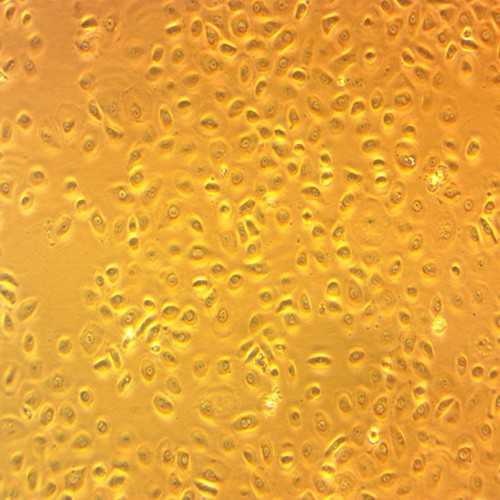Human Endocervical Epithelial Cell Line (A2EN)
Immortalized human epithelial cell line (A2EN; passage >50) derived from human primary epithelial cells expanded from an explant of human endocervical tissue.
Highlights:
- Primary epithelial cells transduced with lentiviral vectors carrying the HPV E6/E7 genes allowing for long term use of cells
- Passages >50 generate a Transepithelial Electrical Resistance (TEER) when grown on cell culture inserts and generate differential apical and basolateral cytokine profiles upon stimulation with various toll-like receptor (TLR) agonists
- Established as a model for STI pathogen infection, pathogenesis, and innate immune response studies
The endocervical epithelium is a single cell layer lining the endocervical canal that separates the lower female reproductive tract from the uterus and Fallopian tubes. Endocervical epithelial cells secrete mucus and innate immune mediators that facilitate reproduction as well as protect from pathogen invasion. The endocervix is a major site of transmission for multiple sexually transmitted organisms, such as Chlamydia trachomatis, Neisseria gonorrhoeae, Mycoplasma genitalium, and Human Immunodeficiency Virus (HIV).
From the laboratory of Alison J. Quayle, PhD, LSU Health Sciences Center.
 Part of The Investigator's Annexe program.
Part of The Investigator's Annexe program.
Immortalized human epithelial cell line (A2EN; passage >50) derived from human primary epithelial cells expanded from an explant of human endocervical tissue.
Highlights:
- Primary epithelial cells transduced with lentiviral vectors carrying the HPV E6/E7 genes allowing for long term use of cells
- Passages >50 generate a Transepithelial Electrical Resistance (TEER) when grown on cell culture inserts and generate differential apical and basolateral cytokine profiles upon stimulation with various toll-like receptor (TLR) agonists
- Established as a model for STI pathogen infection, pathogenesis, and innate immune response studies
The endocervical epithelium is a single cell layer lining the endocervical canal that separates the lower female reproductive tract from the uterus and Fallopian tubes. Endocervical epithelial cells secrete mucus and innate immune mediators that facilitate reproduction as well as protect from pathogen invasion. The endocervix is a major site of transmission for multiple sexually transmitted organisms, such as Chlamydia trachomatis, Neisseria gonorrhoeae, Mycoplasma genitalium, and Human Immunodeficiency Virus (HIV).
From the laboratory of Alison J. Quayle, PhD, LSU Health Sciences Center.
 Part of The Investigator's Annexe program.
Part of The Investigator's Annexe program.
| Product Type: | Cell Line |
| Name: | Human Endocervical Epithelial Cell Line (A2EN) |
| Cell Type: | Epithelial |
| Accession ID: | CVCL_0P36 |
| Source: | Endocervix |
| Organism: | Human |
| Morphology: | Keratinocyte appearance when cultured on plastic; cobblestone appearance with occasional multilayer regions when grown on cell culture inserts |
| Biosafety Level: | 2 |
| Growth Conditions: | Epilife+EDGS or KSFM+BPE/EGF (Either medium supplemented with 0.06mM-0.4mM Calcium Chloride), 5% CO2, 37C |
| Subculturing: | 1 week |
| Cryopreservation: | Growth medium containing 5% FBS + 5% DMSO |
| Storage: | Liquid nitrogen |
| Shipped: | Dry ice |
C. trachomatis-Infected Endocervical Epithelial Cell (A2En) Culture.

The immortalized endocervical epithelial cell line A2EN was exposed to C. trachomatis serovar D at multiplicity of infection of 2 in the absence of cyclohexamide (right two panels). This resulted in a mixed population of infected and uninfected cells. Infected cells are stained green with chlamydial LPS conjugated to FITC (bottom), and nucleic acid is stained with DAPI (blue, top). Uninfected controls are included in the left two panels for comparison. Data is representative of experiments performed greater than 10 times.
Adapted from: Ibana JA., et al. Infect Dis Obstet Gynecol. 2011; 2011: 420905.
- Herbst-Kralovetz MM, Quayle AJ, Ficarra M, Greene S, Rose WA 2nd, Chesson R, Spagnuolo RA, Pyles RB. Quantification and comparison of toll-like receptor expression and responsiveness in primary and immortalized human female lower genital tract epithelia. Am J Reprod Immunol. 2008 Mar;59(3):212-24.
- Ibana JA, Schust DJ, Sugimoto J, Nagamatsu T, Greene SJ, Quayle AJ. Chlamydia trachomatis immune evasion via downregulation of MHC class I surface expression involves direct and indirect mechanisms. Infect Dis Obstet Gynecol. 2011;2011:420905
- Buckner LR, Schust DJ, Ding J, Nagamatsu T, Beatty W, Chang TL, Greene SJ, Lewis ME, Ruiz B, Holman SL, Spagnuolo RA, Pyles RB, Quayle AJ. Innate immune mediator profiles and their regulation in a novel polarized immortalized epithelial cell model derived from human endocervix. J Reprod Immunol. 2011 Dec;92(1-2):8-20.
- Ibana JA, Aiyar A, Quayle AJ, Schust DJ. Modulation of MICA on the surface of Chlamydia trachomatis-infected endocervical epithelial cells promotes NK cell-mediated killing. FEMS Immunol Med Microbiol. 2012 Jun;65(1):32-42.
- Radtke AL, Quayle AJ, Herbst-Kralovetz MM. Microbial products alter the expression of membrane-associated mucin and antimicrobial peptides in a three-dimensional human endocervical epithelial cell model. Biol Reprod. 2012 Dec 6;87(6):132.
- Buckner LR, Lewis ME, Greene SJ, Foster TP, Quayle AJ. Chlamydia trachomatis infection results in a modest pro-inflammatory cytokine response and a decrease in T cell chemokine secretion in human polarized endocervical epithelial cells. Cytokine. 2013 Aug;63(2):151-65
If you publish research with this product, please let us know so we can cite your paper.


